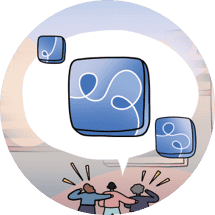Myths and Misconceptions of Opioid Use Disorder
Opioid use disorder (OUD) affects millions of people worldwide. Unfortunately, myths and misconceptions about OUD can negatively impact people living with OUD and make it harder to seek help. Here, we debunk 10 common myths about OUD.1,2
Myth: OUD is a choice
OUD is a chronic medical condition, not a choice. Opioids change the brain’s chemistry over time. This can make it very hard for a person to stop using them without help. Like diabetes or heart disease, OUD requires proper treatment.1,3
Myth: Only certain types of people develop OUD
OUD can affect anyone, no matter their age, gender, background, or socioeconomic status. People may develop OUD after taking opioids for pain management, after an injury, or after surgery. It does not discriminate.4
Myth: People with OUD are weak or lack willpower
OUD is not about weakness. It is a medical condition that changes how the brain works. Recovery does not require willpower alone. Many people need medical treatment, therapy, and support to recover.2,3

It's Giveaway Time!
Enter your email below for a chance to win a 6-month subscription to Skillshare! Get more details about the giveaway here.
Myth: Medication-assisted treatment (MAT) is just replacing 1 drug with another
MAT uses medicines like methadone, buprenorphine, or naltrexone to help people manage OUD. These medicines reduce cravings and withdrawal symptoms, making recovery more achievable. MAT is a proven, effective treatment, not a substitute for addiction.1,3
Myth: People with OUD can quit if they really want to
Quitting opioids is not as simple as just stopping the drugs. Withdrawal symptoms can be severe and even dangerous. Medical supervision is often needed to safely reduce dependence. Long-term support is also critical for recovery.2
Myth: OUD only happens with illegal drug use
OUD can stem from opioids other than illegal drugs like heroin. Many people develop OUD from taking prescription opioids given by their doctors for legitimate reasons. For example, a doctor may prescribe opioids to help manage pain after a surgery. Even when taken as prescribed, these medicines can lead to dependence over time.3
Myth: People with OUD are dangerous or untrustworthy
Stigma often leads people to think the worst about people with opioid use disorder. In reality, most people with OUD are not violent or untrustworthy. They are people struggling with a medical condition, and they need compassion and care.2
Myth: Recovery from OUD is not possible
Recovery from OUD is absolutely possible. With the right combination of treatments, many people recover from OUD. Treatment can include medicine, therapy, and other support. The journey may take time, but it is achievable.1,3
Myth: Naloxone encourages opioid use by reducing the fear of overdose
Naloxone (Narcan®) saves lives by reversing opioid overdoses. There is no evidence that having access to naloxone makes people more likely to use opioids. Instead, it gives people a chance to survive an overdose and seek help.3
Myth: People with OUD do not care about their families or responsibilities
OUD can make it hard for people to prioritize anything besides their next dose. This does not mean they do not care about their loved ones. With treatment and support, people can rebuild their relationships and lives.2
Breaking the stigma around OUD
Stigma and misinformation about OUD can prevent people from getting the help they need. By understanding the truth about this condition, we can create a more supportive and compassionate environment for those affected by OUD. Then, they will be more likely to seek treatment.2
If you or someone you know is struggling with OUD, reach out to a healthcare provider or a support organization. Help is available, and recovery is possible.

Join the conversation